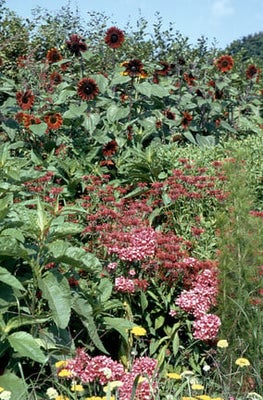
Quick facts
Suitable for - Overgrown, neglected borders
Timing - Late winter
Difficulty - Moderate
Suitable for...
The guide below is suitable for borders that have become overgrown.
When to tackle an overgrown border
Borders can be worked on in late winter, or autumn on light sandy soils.
How to revitalise a border
How much work you put into revitalising a border depends largely on the time you have available and what you want to achieve. Research and planning will ensure the border is top-notch, but it’s a stage that can be skipped if you want a quicker makeover. However, it is still worth reading the planning and research sections for guidance.
Plan it on paper
- Measure the border and draw it out on paper, ideally to scale
- Note which areas of the border are shaded or sunny or influenced by adjacent walls or overhanging canopy
Design considerations
- Work out what you would like to go where. Combine plants that you already have with extra structure or colour for times of year when there may be a lack of interest
- Try not to use a plant just because ‘it’s there’. Would you have chosen it? What you leave out is as important as what you include
- Decide in which season you would like a crescendo of flower colour. Year-round interest can be provided with , evergreens, but trying to have some flower throughout the year can result in a ‘bitty’ appearance
- Aim for a balanced planting; around 30 percent evergreen, 70 percent offers a pleasing results
- See our garden design pages for more inspiration
Practical considerations
- Large shrubs are not easy to move so consider introducing replacements if large specimens are badly positioned
- Choose plants that suit your soil and and plant in groups, if possible, to give a cohesive look
Getting stuck in
- It is best to start with a blank canvas. Dig up all the plants except those in the correct positions and ensure that the plants’ roots do not dry out. Heel them into spare ground or pot into containers
- Prepare the soil by incorporating plenty (one or two bucketfuls per sq m or sq yd) of well-rotted manure or garden . A 7.5-10cm (3-4in) layer of organic matter over the whole weed-free border will condition the soil and help with establishment
- Where organic matter is not availble or where soil is very poor, potassium (potash) rich general fertiliser can be raked in at 70g per sq m (2oz per sq yd)
- To keep the newly planted border weed free, with 7.5-10cm (3-4in) layer of organic matter
- Assuming the soil is free of weeds, you can divide and replant directly
Dealing with weeds
If the border contains weeds whose roots have intertwined with those of plants you are keeping, it will take time and patience to remove the weed roots. Couch grass, ground elder and bindweed are common examples. For more information on methods of weed control, see our Weeds: non-chemical control page.
- Remove as many roots by forking out as possible
- Prepare the border for planting and leave until spring or when regrowth appears. Fork through to remove regrowth of weeds or hoe off annual weeds
- Only when there has been a period of several weeks during the growing season (March-September) with no weed growth can replanting begin
Dividing perennials
- Many herbaceous perennials decline in flowering performance after four or five years when it is time to divide them
- More space can give plants such as irises, heuchera and hemerocallis a new lease of life
Pruning neglected shrubs
- Many shrubs can be renovated by taking out older wood to encourage new shoots from the base. Examples include early flowering and summer flowering such as Philadelphus, Weigela and Deutzia
- Evergreen shrubs such as Camellias, Choisya, Viburnum and Photinia re-shoot from old wood and can be successfully renovated over a couple of years
- Some shrubs such as Cistus, lavender and most conifers are best replaced














